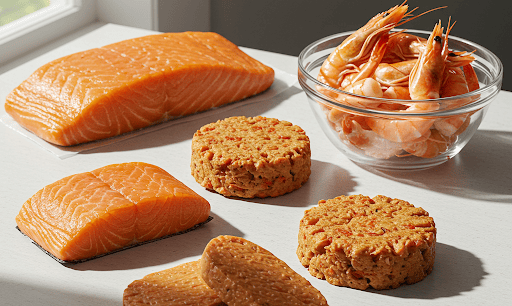Canadian Startup with Whole-Cut Plant-Based Seafoods
SUSTAINABILITYALTERNATIVE PROTEINS


This is an AI generated illustration and does not represent actual product or service.
The alternative protein industry has witnessed significant growth in recent years, with plant-based meat and seafood alternatives becoming more sophisticated. However, creating whole-cut alternatives that truly replicate the texture, structure, and cooking behavior of conventional meat and seafood remains a formidable challenge. Addressing this gap, Canada-based startup, New School Foods has developed a novel technology that significantly enhances the realism of plant-based whole-cut products. Their newly patent pending multi-phase gelation process introduces a new approach to structuring plant-based analogues, offering improved texture, visual appearance, and cooking properties.
The Growing Demand for Whole-Cut Alternatives
The plant-based meat and seafood market is growing rapidly, driven by consumer demand for sustainable and ethical food choices. However, current plant-based offerings predominantly consist of processed products such as burgers, sausages, and nuggets. While these products have gained popularity, replicating whole-cut meats like fish fillets, chicken breasts, and steak remains a major hurdle due to the complexity of their fibrous structure, marbling, and layered textures.
Moreover, plant-based seafood alternatives are severely underrepresented in the market, accounting for just 1% of total plant-based meat alternative sales in 2019. With 90% of the world's wild fish species either overfished or at their maximum sustainable limit, the demand for seafood alternatives is expected to surge. New School Foods’ innovation provides a promising solution to meet this demand.
How the Technology Works
New School Foods’ patent application introduces a multi-phase gelation process that mimics the complex structure of whole-cut animal proteins. The key components of this technology include:
Ingestible Polymer Composition (First Phase):
A fluid or semi-fluid polymer matrix that acts as the base structure of the plant-based meat or seafood.
Configured to gel or increase in viscosity under specific conditions.
Internal Phase Deposition (Second Phase):
One or more additional ingestible compositions are injected into the first phase using a nozzle that moves through the base material.
These additional phases can form fibrous layers, fat marbling, or connective tissue-like structures within the first phase.
Gelation and Structuring:
The combined multi-phase unit is subjected to controlled gelation or viscosification, creating a cohesive structure that closely mimics real meat or seafood.
Key Advantages of the Technology
1. Realistic Whole-Cut Textures
One of the biggest challenges in plant-based meat is replicating the intricate fibrous structure of whole-cut products. This patent enables:
Layered muscle fibers
Fat marbling
Connective tissue replication (e.g., tendons, fascia, and extracellular matrix)
The ability to embed structured phases within the base matrix results in an authentic mouthfeel and texture.
2. Improved Cooking Performance
Unlike many existing plant-based meats that dry out or fall apart when cooked, this technology ensures that the alternative protein product:
Retains juiciness due to structured moisture retention.
Replicates the cooking transformation of animal proteins, including changes in texture and color when exposed to heat.
3. Versatility in Product Development
This process can be tailored to produce a variety of whole-cut products, including:
Plant-based fish fillets with realistic flakiness
Chicken breast analogues with layered muscle fibers
Steaks with embedded marbling for improved juiciness and texture
Additionally, different flavors, nutrients, and functional ingredients can be incorporated into the different phases, further enhancing the nutritional and sensory experience.
4. Scalable and Cost-Effective Manufacturing
Unlike 3D printing-based techniques, which require complex machinery and are limited in material selection, New School Foods’ injection-based process is more adaptable for large-scale production.
The process allows for multiple nozzles to operate simultaneously, making it efficient for mass production.
It supports a range of plant-based ingredients, including protein gels, hydrocolloids, and emulsified fats, providing flexibility in formulation.
Implications for the Future of Plant-Based Meat and Seafood
New School Foods’ multi-phase gelation technology represents a major step forward in the development of realistic plant-based meat and seafood alternatives. With growing consumer demand for sustainable and ethical food options, this innovation has the potential to disrupt the plant-based food industry and accelerate the shift away from animal-based proteins.
As the company works toward commercialization, this technology could define the future of plant-based protein, making sustainable food choices more accessible and appealing to a broader audience.
New School Foods’ patent pending multi-phase gelation process is a game-changer in the plant-based food industry. By overcoming the long-standing challenge of replicating whole-cut meat and seafood, this innovation paves the way for a more sustainable, ethical, and delicious future.
